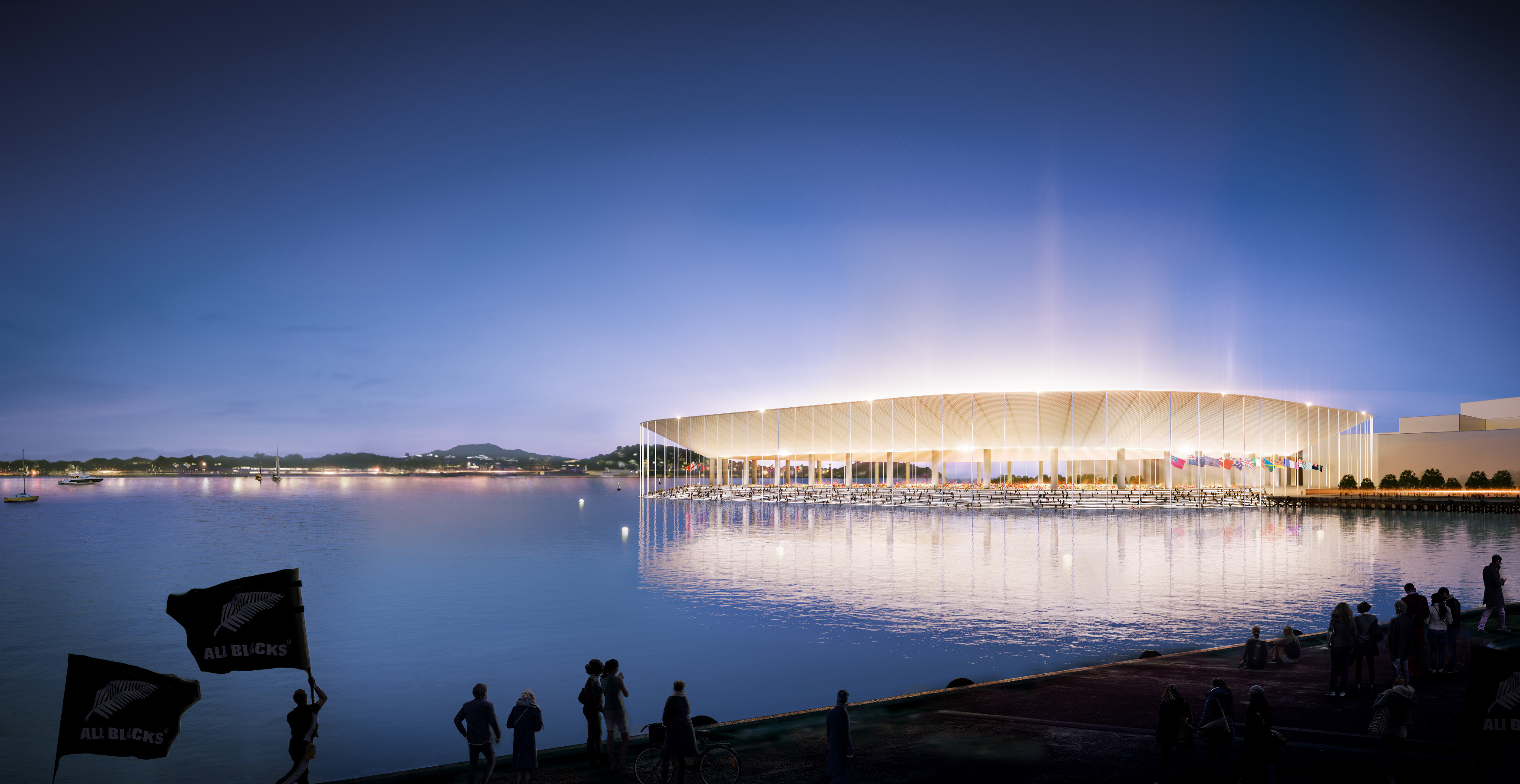Auckland could have an iconic waterfront stadium within 10 years at zero cost to ratepayers and taxpayers if a proposal from some of the city’s leading companies is adopted

The Auckland Waterfront Consortium has launched an ambitious proposal that would see a spectacular 50,000 seat fully enclosed stadium, built alongside a redeveloped Bledisloe Wharf.
The stadium would be the centerpiece of a world-class waterfront that would be breathtakingly beautiful, with public access to the water’s edge.
The consortium, which has been self-funded, is made up of leading Auckland-based companies Ernst & Young, Simpson Grierson, Jones Lang Lasalle, ENGEO, Peddle Thorp, Planning Focus, Phil O’Reilly Design, Rider Levett Bucknall, Buildmedia and The Property Strategists, as well as USA-based global stadium architects HOK.
“We are a group of professionals who are deeply invested in our city and who understand the realities of a project of this scale and its regional and national significance,” Consortium chair Dave Wigmore says.
The consortium has spent the last 18 months working up their proposal which includes development of the multi-purpose, fully enclosed stadium, previously dubbed ‘The Crater’, sunk into the seabed alongside Bledisloe Wharf, the redevelopment of the wharf as a mixed use Bledisloe Quarter, and the redevelopment of Eden Park for residential use.
The stadium can be upsized to 65,000 for major events and down sized for smaller events.
“Our proposal is exciting, very ambitious but represents a superb solution for the waterfront and the city as a whole. Importantly, it is financially feasible and achievable,” says Wigmore.
“It is the most advanced waterfront stadium proposal on the table, the only one that delivers a stadium at zero cost to ratepayers and taxpayers and the only proposal that would see a stadium delivered within 10 years.”
Wigmore says the consortium has socialised the proposal to as many stakeholders as possible before going public.
“Every part of the proposal has been formulated in a way that is intended to protect and enhance the interests of all affected stakeholders.
“Each of these is part of the fabric that makes up Auckland and we are committed to an approach that makes every part of that fabric stronger.”
Wigmore says the consortium has talked to the mayor’s office, key ministers, local and central government organisations, Ports of Auckland and a range of other stakeholders, and are in the process of engaging with Ngati Whatua.
“The feedback from stakeholders so far has been overwhelmingly positive.”
Wigmore says the stadium will be a spectacular landmark on Auckland’s waterfront and all parts of the development will employ a sustainable design philosophy that demands world-class aesthetics and functionality.
He says Auckland needs a world-class, fully roofed stadium in a readily accessible location and the city has a once only opportunity to get this right.
“Sinking the stadium into the seabed eliminates most of the contentious, costly and complex aesthetic and engineering issues of an above ground stadium and is very doable from an engineering perspective.
“The stadium will not encroach into the harbor beyond the northern tip of Bledisloe Wharf, will involve the removal of other obsolete wharves, ensuring the net seabed take is minimised.”
The stadium’s design and engineering will be in accordance with international best practice to meet accepted seismic design principles and recommendation on rising sea levels and tsunami modelling.
Wigmore says the development of the stadium will be funded entirely by the development of commercial and residential precincts on the current sites of Bledisloe Wharf and Eden Park and by avoiding future maintenance costs at Mt Smart Stadium.
Bledisloe Quarter will feature approximately 2,500 new inner city dwellings housing more than 6,000 residents, commercial areas accommodating more than 6,000 employees and would contribute to the revitalisation of Auckland’s downtown area as an attractive place to live, work and visit.
“We have both a need and an opportunity to open up more of the waterfront to the public and, in doing so, turn an eyesore into something magnificent.”
The proposed development would require the removal of car importing operations from Bledisloe Wharf, but would not affect the remainder of Ports of Auckland’s freight operation.
“We need to begin the process of reducing the footprint of port operations at the waterfront, without damaging the viability of Ports of Auckland.”
Wigmore says the proposal would ultimately lead to a fully connected waterfront precinct, from Wynyard Quarter to Bledisloe Quarter, where all of the public, commercial, transport and maritime features are seamless, functional and beautiful.
“We want to begin the redevelopment of the central and eastern sections of the waterfront in a way that will make it easier, not harder, for other needs to be met.”
Wigmore says while the project will not be publicly funded, it will require leadership, vision and support from Auckland Council and the Crown.
The consortium plans to continue discussions with all stakeholders before undertaking a detailed feasibility study and putting together a proposal to attract a lead investor / developer.
“We believe the commercial opportunity is such that there is likely to be intense competition between developers to lead this project and we would welcome that,” Wigmore says.
Former Prime Minister Helen Clark, Sir Graham Henry, Sir John Kirwan and Heart of the City CEO Viv Beck are among prominent individuals who have publicly supported a waterfront stadium for Auckland, as have New Zealand Rugby League, the NRL, NZ Football and entertainment promoters Live Nation.
“We believe there is a strong public sentiment in favour of a waterfront stadium for Auckland if it is affordable and doable.
“Our proposal delivers that.”



